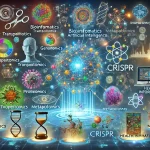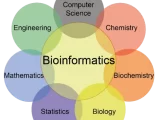
Python vs. R for Genomic Data Analysis: A Comprehensive Guide
February 22, 2025Navigating the Genomic Data Landscape
Genomic data analysis is akin to navigating an intricate labyrinth filled with massive datasets, complex sequences, and high-dimensional biological insights. Researchers rely on computational tools to extract meaningful patterns from this wealth of information. Python and R, two of the most powerful programming languages in bioinformatics, serve as indispensable guides in this journey. Each language offers unique strengths: Python’s seamless machine learning integration and high scalability contrast with R’s superior statistical modeling and specialized bioinformatics packages. This guide delves into the key differences and advantages of Python and R, helping researchers make an informed choice for their genomic data analysis workflows.
Key Takeaways
- Python: Excels in machine learning integration with libraries like Biopython, scikit-learn, and TensorFlow.
- R: Specializes in advanced statistical modeling, with powerful bioinformatics tools available in the Bioconductor project.
- Data Manipulation: Python’s Pandas vs. R’s data.table and dplyr for efficient dataset handling.
- Visualization: Python’s Matplotlib, Seaborn, and Plotly vs. R’s ggplot2 for high-quality graphics.
- Scalability: Python integrates with cloud platforms and supports parallel processing, whereas R has challenges with large datasets.
Key Features of Python in Genomic Data Analysis
Python provides an extensive ecosystem of libraries that streamline genomic data processing. These tools enhance efficiency, scalability, and interoperability with other bioinformatics resources:
- Biopython: Offers functionalities for reading sequence files, aligning sequences, and accessing biological databases.
- scikit-learn, TensorFlow, PyTorch: Enable machine learning applications, such as gene expression prediction and variant classification.
- Pandas & NumPy: Essential for manipulating genomic datasets and performing numerical computations.
- Matplotlib & Seaborn: Provide powerful visualization tools for plotting genomic trends and relationships.
- PyVCF & pysam: Support handling VCF and BAM files for variant calling and sequence alignment.
- Parallel Processing: Python’s multiprocessing and Dask libraries enhance scalability, making it suitable for large-scale genomic projects.
Key Features of R in Genomic Data Analysis
R has long been the preferred language for statistical computing and bioinformatics due to its specialized tools:
- Bioconductor: A repository of bioinformatics packages optimized for high-throughput genomic analysis.
- data.table & dplyr: Provide fast and memory-efficient data manipulation capabilities.
- ggplot2: An industry-standard library for creating publication-quality visualizations.
- Advanced Statistical Analysis: R excels in hypothesis testing, regression modeling, and survival analysis.
- Genome-Wide Association Studies (GWAS): Specialized tools such as SNPRelate enable large-scale genetic studies.
Comparison of Data Handling Capabilities
Both Python and R offer robust data management tools, but their performance varies depending on dataset size and complexity.
| Feature | Python (Pandas) | R (data.table/dplyr) |
|---|---|---|
| Syntax | Intuitive, user-friendly | Concise, expressive |
| Speed | Moderate | High |
| Memory Management | Adequate, potential leaks | Highly efficient |
| Integration | Excellent with ML frameworks | Seamless with statistical models |
Python’s garbage collection mechanism supports memory management but may struggle with very large datasets. In contrast, R’s lazy evaluation and copy-on-modify semantics improve memory efficiency.
Visualization Techniques
Effective data visualization is critical for interpreting complex genomic relationships. Python and R each offer powerful tools:
- Python (Matplotlib, Seaborn, Plotly):
- Ideal for interactive and exploratory visualizations.
- Supports heatmaps, scatter plots, and hierarchical clustering.
- Best suited for web applications and dashboards.
- R (ggplot2, lattice, ComplexHeatmap):
- Excels in generating high-quality static images for publications.
- Offers highly customizable aesthetics with minimal code.
- Preferred for detailed statistical plotting.
Performance and Scalability
Scalability plays a crucial role in genomic data processing. Python’s robust memory management and parallel computing support make it more suitable for large-scale projects:
- Python:
- Uses Dask and multiprocessing for efficient parallel execution.
- Integrates seamlessly with cloud services like AWS, Google Cloud, and Microsoft Azure.
- Well-suited for high-performance computing (HPC) environments.
- R:
- Traditionally single-threaded but supports parallel computing via packages like future and parallel.
- Less efficient for extremely large datasets but excels in statistical genomics.
Frequently Asked Questions
1. What Are the Best Practices for Managing Genomic Data Privacy and Security?
Genomic data privacy and security require robust encryption, strict access controls, and compliance with ethical guidelines such as HIPAA and GDPR. Encryption ensures data confidentiality during storage and transmission, while access control mechanisms prevent unauthorized access.
2. How Can I Integrate Python and R in a Single Workflow?
Integration can be achieved using:
- Reticulate (R package) to call Python scripts within R.
- rpy2 (Python package) to execute R functions within Python.
- Jupyter Notebooks to facilitate cross-language scripting.
3. What Are the Recommended Cloud Platforms for Genomic Data Analysis?
- AWS: Provides scalable storage and analysis tools, including Amazon S3 and AWS Lambda.
- Google Cloud: Integrates with BigQuery and Data Studio for large-scale genomic computations.
- Microsoft Azure: Offers advanced machine learning tools for bioinformatics workflows.
Conclusion: Python or R?
The choice between Python and R ultimately depends on the specific needs of the genomic research project. Python is the preferred option for large-scale data processing, machine learning applications, and cloud-based scalability. R, on the other hand, remains the gold standard for statistical modeling, visualization, and specialized bioinformatics workflows. Many researchers adopt a hybrid approach, leveraging the strengths of both languages to optimize their analyses.
By understanding the unique capabilities of Python and R, genomic scientists can harness the power of computational tools to unlock deeper insights into the mysteries of the genome.















